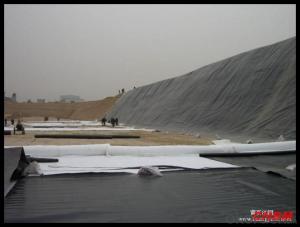Textured geomembranes, which are synthetic materials, have found increasing usage in construction and environmental sectors because of their adaptability and strength. They are designed to resist tough conditions for various uses as well. In my years in the industry, I’ve seen how textured geomembranes influence projects first-hand and I am excited to share with you what I think.
What Are Textured Geomembranes?
Textured geomembranes are crafted from high-density polyethylene (HDPE) or other polymers such that they possess a textured surface. This texturing adds strength to them and protects against punctures thereby rendering them ideal for use in situations where membranes may come into contact with sharp objects or rough terrains. Also, while being installed, the texture helps the membrane to adhere more effectively onto the underlying surface.
Benefits of Textured Geomembranes
The main benefit of these types of membranes is their capacity to restrict water leakage. They form a waterproof barrier which is necessary for applications like landfill liners, reservoirs, canal linings etc. Moreover, such membranes are resistant to chemicals, UV radiations as well as temperature changes thus having a long life span with little maintenance required.
Applications of Textured Geomembranes
The applications textured geomembranes can be put into include but not limited to:
Landfill liners that prevent hazardous waste seepage.
Pond and reservoir liners used for water conservation and management purposes.
Canal and dam linings meant for water flow control.
Roofing systems designed for waterproofing and weather protection.
Foundation protection aimed at buildings or infrastructure.
Installation Process
The installation process of textured geomembrane materials is very careful; it requires an elaborate plan and execution strategy. The procedure includes:
Preparation of substrate so that the area will be smooth, stable and clean
Rolling out the membrane over the prepared area accurately
Securing the membrane by utilizing unique techniques like welding or mechanical fastening
Examination of the installation to determine any errors or differences.
Personal Experience with Textured Geomembranes
In my career, I have had a number of projects where I got to work with textured geomembranes. One such project was a large-scale reservoir construction. The textured geomembrane was instrumental in ensuring that the reservoir was structurally sound and waterproofed. It was amazing to see how simply having a textured surface provided enough grip and protection against the elements.
Challenges and Solutions
Notwithstanding their numerous advantages, installation and use of textured geomembranes can sometimes face some difficulties. For instance, sometimes it can make handling and maneuvering more difficult due to its textured surface. Nevertheless, these issues can be effectively dealt with through proper training and use of specialized equipment.
Innovations in Textured Geomembranes
New developments are being made on a regular basis since the industry is ever-changing; innovations in textured geomebranes are being created for better performance as well as flexibility. Some of the latest include;
Addition of enhanced chemical resistance properties so that they may be used in more aggressive environments.
Creating better UV protection so that membranes have longer life spans.
Making them capable of self-repairing hence making minor damages irrelevant
It is my belief that textured geomembranes will continue to have a huge effect on different industries as sustainable and efficient construction materials are in demand. For they offer long lasting and dependable solution of keeping out water and protecting structures, these membranes are indispensible.
Conclusion
Textured geomembranes have become invaluable assets in the fields of construction and environmental management. They are popular among professionals and fans because of their exceptional traits and applications. Having personally experienced their advantages; I can say for sure that these membranes play a critical role in developing strong enduring functional buildings. The future looks great for textured geomembranes and I am excited to see what innovations lie ahead.







